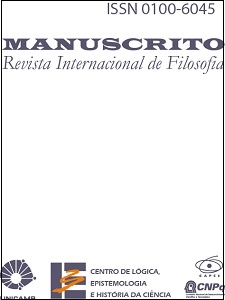Resumen
An experimental realization of quantum computers is composed of two or more calcium ions trapped in a magnetic quadripole. Information is transferred to and read from the ions by means of structured lasers that interact with the ions’ vibration pattern, causing changes of energy distribution in their electronic structure. Departing from an initial state when the ions are cooled, the use of lasers modifies the internal state of one ion that is entangled with the others, then changing the collective states. In such quantum computers, some of the physically possible electronic states are avoided or not taken into consideration, to force the system to work as a binary device. In this essay, we discuss the dynamics that the ions could spontaneously display and its possible implications for the principles of computational logics.Citas
BAIN, J. (2005) “Modal Interpretations and Quantum Logic”. URL = http://ls.poly.edu/~jbain/philqm/philqmlectures/11.Modal&QL.pdf
BICKLE, J. “Multiple Realizability”. The Stanford Encyclopedia of Philosophy (Fall 2002 Edition), Edward N. Zalta (ed.) URL = http://plato.stanford.edu/entries/multiple-realizability/
BUB, J. “The Philosophy of Quantum Mechanics”. British Journal for the
Philosophy of Science, 40(2), pp. 191-211, 1989.
CARAFOLI, E. “Calcium Signaling: a tale for all seasons”. Proc. Natl. Acad. Sci., 99(3), pp. 1115-1122, 2002.
CIRAC, J.I. and ZOLLER, P. “A Scalable Quantum Computer with Ions in
an Array of Microtraps”. Nature, 404, pp. 579-581, 2000.
HUGHES, R.J. et al. “The Los Alamos Trapped Ion Quantum Experiment”. Fortschritte der Physik, 46, pp. 329-361, 1998.
JAISWAL, J.K. “Calcium - How and Why?”. J. Biosci., 26(3), pp. 357-363,
JAMMER, M. The Philosophy of Quantum Mechanics: the interpretations of quantum mechanics in historical perspective. New York: John Wiley and Sons, 1974.
KIELPINSKI, D., MONROE, C. and WINELAND, D.J. “Architecture for a Large-Scale Ion-Trap Quantum Computer”. Nature, 417, pp. 709-711, 2002.
LOEWENSTEIN, W.R. The Touchstone of Life: Molecular Information, Cell
Communication and the Foundations of Life. New York: Oxford University
Press, 1999.
MCCULLOUGH, W.S. and PITTS, E. “A Logical Calculus of the Ideas
Immanent in Nervous Activity”. Bulletin of Mathematical Biophysics, 5,
pp. 115-133, 1943.
NIELSEN, M.A. and CHUANG, I.L. Quantum Computation and Quantum
Information. Cambridge: Cambridge University Press, 2000.
PEREIRA JR., A. and LUNGARZO, C. “A Framework for the Computational Approach to Cellular Metabolism Supporting Neuronal Activity”. International Journal of Computational Cognition, 3(3), pp. 87-92, 2005.
MILBURN, G.J., SCHNEIDER, S, and JAMES, D.F.V. “Ion Trap
Quantum Computing With Warm Ions”. Fortschritte der Physik, 48, pp.
-810, 2000.
SCHMIDT-KALER, F. et al. “Realization of the Cirac-Zoller ControlledNOT
Quantum Gate”. Nature, 422, pp. 408-411, 2003.
SCHNEIDER, S., JAMES, D.F.V. and MILBURN, G.J. “Method of Quantum Computation with ‘Hot’ Trapped Ions”. ArXiv:quantph/9808012 v1 7 Aug 1998, 2004.

